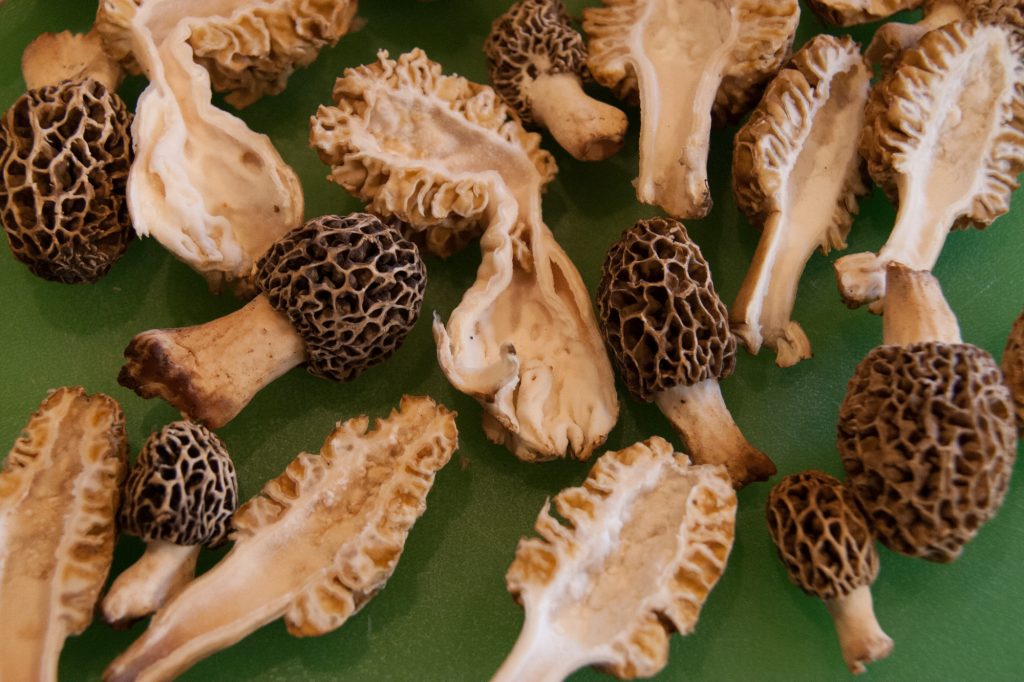
The first time I found morels (Morchella species) I’d been standing on top of them for at least five minutes before I saw them. It’s not just that they grow under leaf litter, they’re also well camouflaged to blend in with their surroundings. Morel hunters move slowly when they find a patch of mushrooms. One false move and you might squash your harvest.
People go nuts for morels. Yes, they’re delicious, but more importantly, they’re one of the earliest wild mushrooms to appear in spring, when foragers are starved for wild edibles and the thrill of the hunt. So many of our favorite fungi are fall mushrooms…a spring crop is something to celebrate. Morel season usually begins when daytime temperatures are in the 60s and 70s, and nighttime temperatures stay above 40F. Soil temperatures will be in the 50s. (Yes, some enthusiastic morel hunters actually measure the soil temperature.)
There’s debate over exactly how many species of morels exist.
The more common species include yellow morels, gray morels, and black morels. Generally, all of these grow best in warm, moist conditions, often close to dead or dying deciduous trees such as elms, cottonwoods, oaks, and ash, and in old orchards. On the West Coast, morels are often found close to Douglas fir and other conifers. Also in the West, large crops often follow forest fires. There, the gray morel is sometimes called the fire morel, due to its close relationship with burned ground.
Beginning morel hunters often fear the false morel. There are several species of mushrooms with this common name, but the most common is Gyromitra esculenta. This fear is unfounded, as it is VERY easy to tell the difference between false and true morels. First and foremost, morels are hollow from head to toe. If you find what you think is a morel, slice it open lengthwise. A true morel is entirely hollow. If your mushroom is not hollow (both stem and cap) you do NOT have a true morel. True morels also have a distinctive cap; it is spongy and netted. False morels, on the other hand, look more like a brain on a stick instead of a net on a stick. Their caps look folded rather than netted. While some people enjoy eating false morels, there are enough reports of gastrointestinal distress to make me cautious. I recommend sticking to true morels.
Forager’s Tip for Morels
The indentations on morels can hold dirt and sand, but these are delicate mushrooms and don’t respond well to being scrubbed or brushed. Instead, fill a bowl with room temperature water and gently swish your morels around in the water to remove any debris. Then, let them drain on a paper towel until you’re ready to cook them. The prohibition against washing mushrooms is foolish and unnecessary. Most mushrooms simply don’t absorb that much water and what they do absorb is easily cooked off. If you don’t believe me, ask Harold McGee, Alton Brown, or Jacques Pepin.
What to do with Your Morel Harvest
If you don’t have time to cook your morels right away, the best way to preserve them is by drying. Slice each mushroom in half, then spread them out on a dehydrator tray and dry them until they are brittle. This may take between 12-24 hours, depending on where you are. Morels can be rehydrated by pouring boiling water over them and letting them steep for 15 minutes. Save the liquid to use in whatever you’re cooking; it will be very flavorful.
Morels may be anywhere from two to ten inches tall and larger specimens are great for stuffing with pancetta, crabmeat, or chopped up morels. But any size is worth eating. Leave them chunky, so your guests can admire the lovely pattern of their caps. Morels are an excellent addition to risotto, bread pudding, or baked in a mushroom puffed pastry.
Morels and caraway seeds cooked with scrambled eggs is very good.
Where would I go to find them?
I live in Northeast Ohio Near l Lake Erie.
We have a large amount of woods to forage in …. but what specific area would I look for them at/in?
Hi Jeanne, I’ve never foraged where you live, so I can’t be much help. Morels often grow in conjunction with certain trees. Where I live (NM) they tend to grow near cottonwoods, but that doesn’t help you! I suggest looking for a local mushroom club. although most foragers guard their morel spots fiercely!